Report

Executive summary
Covid-19 caused an unprecedented fall in luxury market size
The 19th edition of the Bain Luxury Study, published by Bain & Company for Fondazione Altagamma, the trade association of Italian luxury goods manufacturers, analyzed recent developments in the global luxury goods industry, as well as its future outlook.
The luxury industry as tracked by Bain & Company encompasses both luxury goods and experiences. It comprises nine segments, led by luxury cars, luxury hospitality and personal luxury goods, which together account for more than 80% of the total market.
The luxury industry has been heavily impacted by the Covid-19 crisis in 2020. The overall luxury market—encompassing both luxury goods and experiences—shrank by 20% to 22% at current exchange rates, and is now estimated at approximately €1 trillion globally, back to its 2015 levels.
Bain’s Claudia D’Arpizio and Federica Levato discuss the pandemic’s effect on the luxury market in 2020 and how this massive disruption is shaping the industry’s future.
Sales of luxury cars continued to dominate the market, but declined by 8% to 10% at current exchange rates to €503 billion. Most luxury experiences (including luxury hospitality, cruises and fine dining) were disproportionately impacted (–56% at current exchange rates) and should be last to recover given their dependence on tourist flows. Experience-based goods (including fine art, luxury cars, private jets and yachts, fine wines and spirits, and gourmet food) resisted better, declining by only 10% at current exchange rates. They should recover rapidly from the 2020 shock given positive consumption dynamics across most segments.
Personal luxury goods were severely impacted
The market for personal luxury goods—the “core of the core” of luxury segments, and the focus of this analysis—contracted for the first time since 2009, falling by 23% at current exchange rates to hit €217 billion. This drop is the largest recorded since Bain has been tracking the industry. Uncertainty will hover over the industry for some months to come.
An accelerated shift to local purchasing, driven by China
Mainland China has been the only region globally to end the year on a positive note, growing by 45% at current exchange rates to reach €44 billion. Local consumption has roared ahead across all channels, categories, generations and price points.
Europe has borne the brunt of a collapse in global tourism. Consumption on the continent fell by 36% at current exchange rates to €57 billion.
The Americas experienced less impact—the market fell by 27% at current exchange rates to €62 billion. In the US, department stores face an uncertain future, and the map of luxury consumption has been redrawn to move away from city centers.
Japan shrank by 24% at current exchange rates to €18 billion. The rest of Asia also struggled, with Hong Kong and Macau among the worst performers globally. The region contracted by 35% at current exchange rates to reach €27 billion.
The impact in the Middle East was mitigated by shorter lockdowns and repatriation of spending previously made abroad. In Australia, a slowdown from the wildfires was amplified by the halt of tourism. Overall, the rest of the world contracted by 21% at current exchange rates to €9 billion.
The regional shifts mark an acceleration of a rebalancing of where luxury purchases are made as tourists shift to buy in their home markets. The share of purchases made locally reached 80%–85% this year, and in the years ahead we expect it to represent between 65% and 70% as domestic purchases regain relevance especially in China and the broader Asian region.
Online channel accelerates, while stores will be redefined
The changes brought by Covid-19 increased the presence of online in every aspect of life. In the luxury market, online sales made up €49 billion in 2020, up from €33 billion in 2019. The share of purchases made online nearly doubled from 12% in 2019 to 23% in 2020.
Online is set to become the leading channel for luxury purchases by 2025, fueling the omnichannel transformation.
This dramatic increase comes at the expense of brick-and-mortar. We expect no growth in the number of stores operated directly by brands in 2020, and a possible decline in store footprints in 2021. Brands will need to adjust their networks to the new map of luxury buying, evolve the store role and its ergonomics and maximize the customer experience. The wave of transformation will not leave wholesale distribution untouched: Perimeter contraction, polarized performance and entry of new players will lead luxury brands to increase their control on the channel. Meanwhile, the secondhand market for luxury goods rose by 9% to €28 billion.
All personal luxury goods categories have seen declines in 2020
Despite a strong deceleration, accessories remained the largest personal luxury goods category.
Shoes and jewelry were the product categories that decelerated the least. Shoes were cushioned by demand in sneakers, falling by only 12% to €19 billion, while jewelry saw sustained demand in Asia and benefited from online sales. That category remains polarized with high jewelry and iconic, entry-priced items leading the recovery.
Watches and apparel both declined by 30%. For watches, Covid-19 amplified secular consumption pattern shifts. In apparel, formal wear demand was in sharp decline and apparel players faced increasing competition from social media savvy, direct-to-consumer brands.
Across product categories, entry-price items gained in relevance, reaching more than 50% of volumes sold in 2020. In the quest for pricing relevance, the rules of the game are rapidly changing accessible luxury as we knew it, due to increasing competition from new, insurgent brands with relevant purpose and innovative business models.
The turmoil of Covid-19 has been a catalyst for change for the luxury industry
It has been a year of profound change in the way global luxury consumers live and shop, and in what they value. Scenarios for 2021 are varied, and Bain forecasts growth that ranges from +10%/12% to +17%/19% depending on macroeconomic conditions, the evolution of Covid-19 and the speed of return to travel globally, as well as the resilience and confidence of local customers.
The decline in revenue in 2020 should take a disproportionate toll on profitability—we expect operating profit to decline by 60% in 2020 compared with 2019 (i.e., from an average of 21% margin to 12% margin). According to our analysis, in 2021 the market is expected to recover 50% of the profit loss of 2020—but still remain below 2019 levels.

Pandemic Spurs a Transformation of the Luxury Market
With sales down significantly in 2020, luxury retailers are reinventing themselves to survive.
We expect sales recovery to gather pace over the next three years, with the personal luxury goods market returning to 2019 levels by the end of 2022 or early 2023.
Luxury brands have faced a year of tremendous shifts, but the industry should come out of the crisis with more purpose and dynamism than before. By 2030, the industry should be drastically transformed. We will not talk of the luxury industry anymore, but of the market for “insurgent cultural and creative excellence.” In this new, enlarged space, winning brands will be those that build on their existing excellence while reimagining the future with an insurgent mindset. Luxury players will need to think boldly to rewrite the rules of the game, transforming their operations and redefining their purpose to meet new customer demands and retain their relevance, especially for younger generations, who are set to drive 180% of the growth in the market from 2019 to 2025.

1. Luxury spending trends in 2020
- The global luxury market tracked by Bain & Company comprises nine segments: luxury cars, personal luxury goods, luxury hospitality, fine wines and spirits, gourmet food and fine dining, high-end furniture and housewares, fine art, private jets and yachts, and luxury cruises. Overall, the luxury market declined by 20% to 22% at current exchange rates in 2020, to an estimated €1 trillion, with all segments declining in real terms. Luxury cars, luxury hospitality and personal luxury goods together accounted for 80% of the total market.
- Sales of luxury cars continued to dominate the market, but declined by 8% to 10% at current exchange rates, down to €503 billion. We observed nuanced impact across segments and brands, with selected players in the aspirational and absolute segments performing significantly better than market average. The transition toward green-powered trains accelerated across all countries except the US, where it was slowed by policy in favor of fossil fuels. The Covid pandemic outbreak postponed investments toward autonomous vehicles.
- Luxury hospitality severely declined, by 55% to 65% at current exchange rates. The market was significantly impacted by lockdown measures, with occupancy rates decreasing by over 30 percentage points globally. In select countries, hotels fulfilled a “medical” function to host people in quarantine. Luxury hotels, which will have to win back their clientele when global travel resumes, experimented with alternative forms of stay (e.g., “work-from-hotel”) to stay relevant. Trusted brands played a meaningful role as quality assurance in light of safety-related concerns.
- High-end food and fine dining declined by 15% to 17% at current exchange rates, with significant differences in performance across segments: Fine dining was strongly impacted by closures and tourism contraction; conversely, high-end food captured a rising share of consumption, albeit not sufficiently to offset the impact on the entire segment. Fine dining experimented with innovative ways to keep in touch with their customers (e.g., “cook-at-home” kits).
- Sales of fine wines and spirits decreased by 10% to 13% on average at current exchange rates. In wines, the segment of super-high-end brands proved more resilient than entry-to-luxury due to its stronger connection with personal gratification and collection. The sparkling segment was overly impacted due to its strong link with celebratory occasions. Spirits were more resilient than wines due to a historically higher weight of at-home consumption (to avoid the “drink-and-drive” issue). Gin remained on-trend, and tapped into new geographies (such as Africa) through the rise of local craft brands. Sophistication remains a critical trend, as customers prefer quality over quantity in wines, cocktails and spirits.
- Sales of private yachts and jets declined by 10% to 12% at current exchange rates. Luxury yacht deliveries showed resilience, with a flat trend compared with 2019, favored by strong order books, with some shipyards even increasing deliveries vs. 2019. In general, order intakes slowed down due to the global economic uncertainty, yet at a lower rate than other luxury segments, with customers willing to secure an “intimate” luxury experience for the coming years. Customers also showed continued interest for sustainable solutions in design. In private jets, we observed nuanced performance across brands and rising demand for secondhand jets. Ultra-high-net-worth individuals are expected to show sustained demand in the years ahead, with private jets viewed as a viable alternative to commercial travel.
- The fine art market shrank even more substantially than last year (–35% to 40%). We observed a sharp impact on both auctions and private sales, as supply shrank in light of global uncertainty. There were also challenging conditions for small and medium galleries, which lacked scale to invest behind a shift to online. Customers showed growing interest in Black and Latino artists in light of global social movements in favor of diversity. Online penetration increased, broadening the circle of potential buyers to include new generations.
- High-end furniture and housewares experienced negative growth of –10% to 12%. The core high-quality design market sustained with the growing role of homes as personal “cocoons,” with rising needs for personalization, self-expression and functionality. The lighting and accessories categories experienced strong traction, with lighting continuing its functional evolution beyond pure aesthetics. The “resi-mercial” trend accelerated, fueled by the blurring boundaries between living and working spaces, with comfort an increasingly relevant purchasing criteria (alongside pure design). The deceleration of the hospitality and retail segments induced a slowdown of the contract market.
- Most luxury experiences (including luxury hospitality, cruises and fine dining) were disproportionately impacted (–56% at current exchange rates) and should be last to recover given their dependence on tourist flows. Experience-based goods (including fine art, luxury cars, private jets and yachts, fine wines and spirits, and gourmet food) resisted better, declining by only 10% at current exchange rates. They should recover rapidly from the 2020 shock due to positive consumption dynamics across most categories.
- The market for personal luxury goods contracted for the first time since 2009, falling by 23% at current exchange rates to hit €217 billion. This drop is the largest recorded since Bain has been tracking the industry. Uncertainty will hover over the segment for some months to come. Following on the second quarter, which was the worst the sector has ever experienced, there were signs of recovery in the third quarter. The most likely outcome in the fourth quarter is a –10% year-over-year drop, which is heavily dependent on the future evolution of Covid-19 and the additional restrictions that national governments could put in place.
The global luxury market contracted to €1 trillion in 2020, down 20% to 22% from 2019

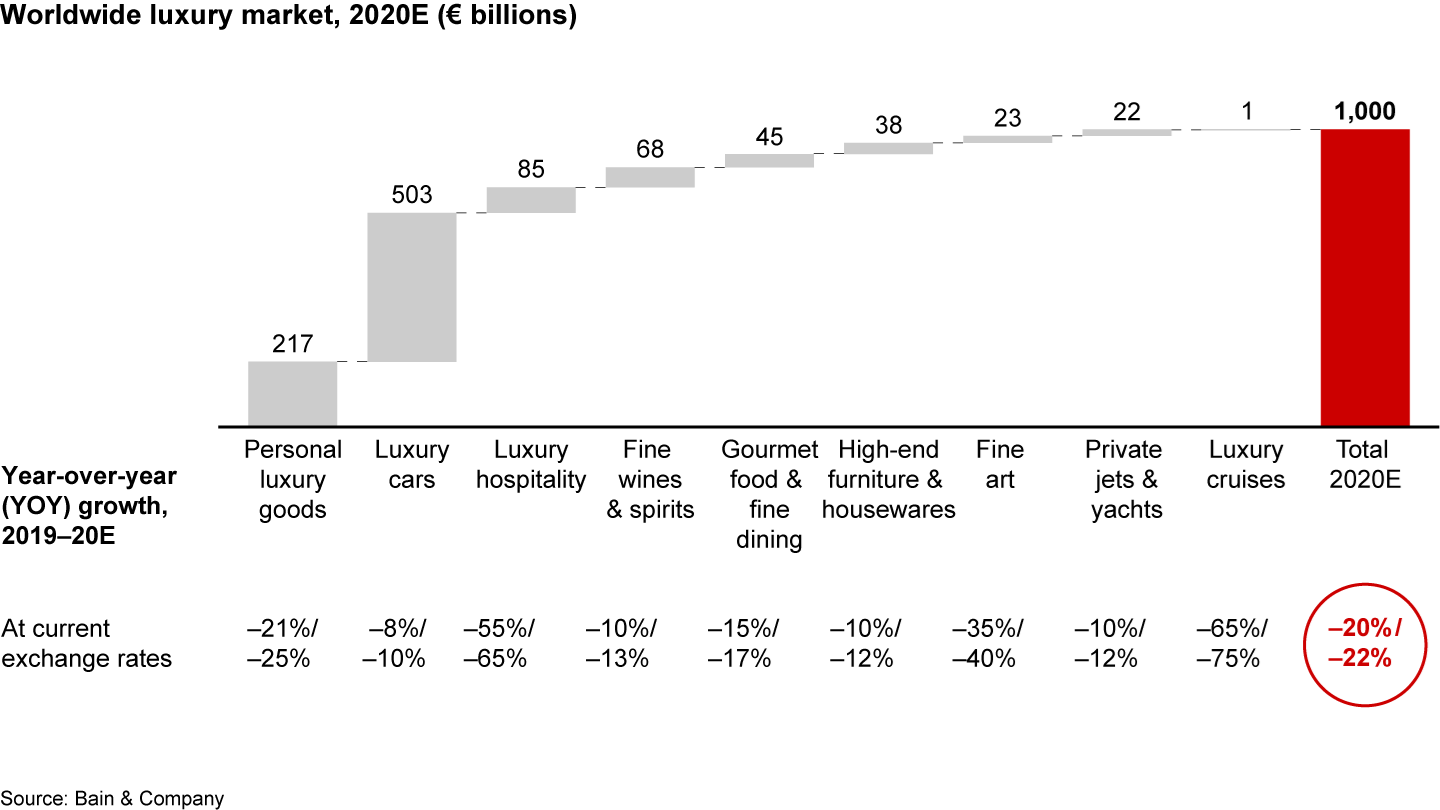
Experience-based goods suffered less in 2020 and should recover faster than personal luxury goods; experiences will recover last given their reliance on tourism

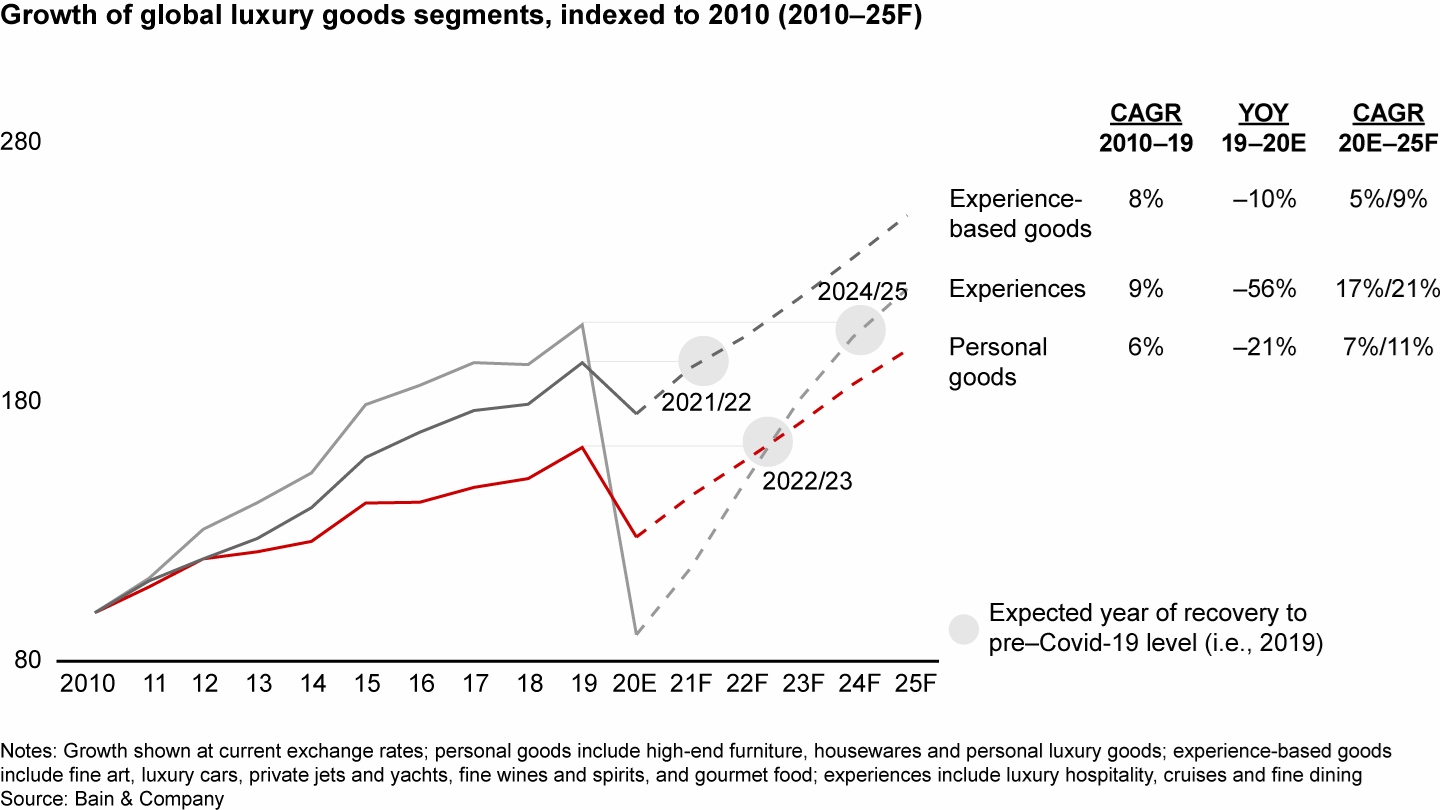
Covid-19 interrupted the “new normal” path of the personal luxury goods market in 2020, leading to the first market contraction in over a decade

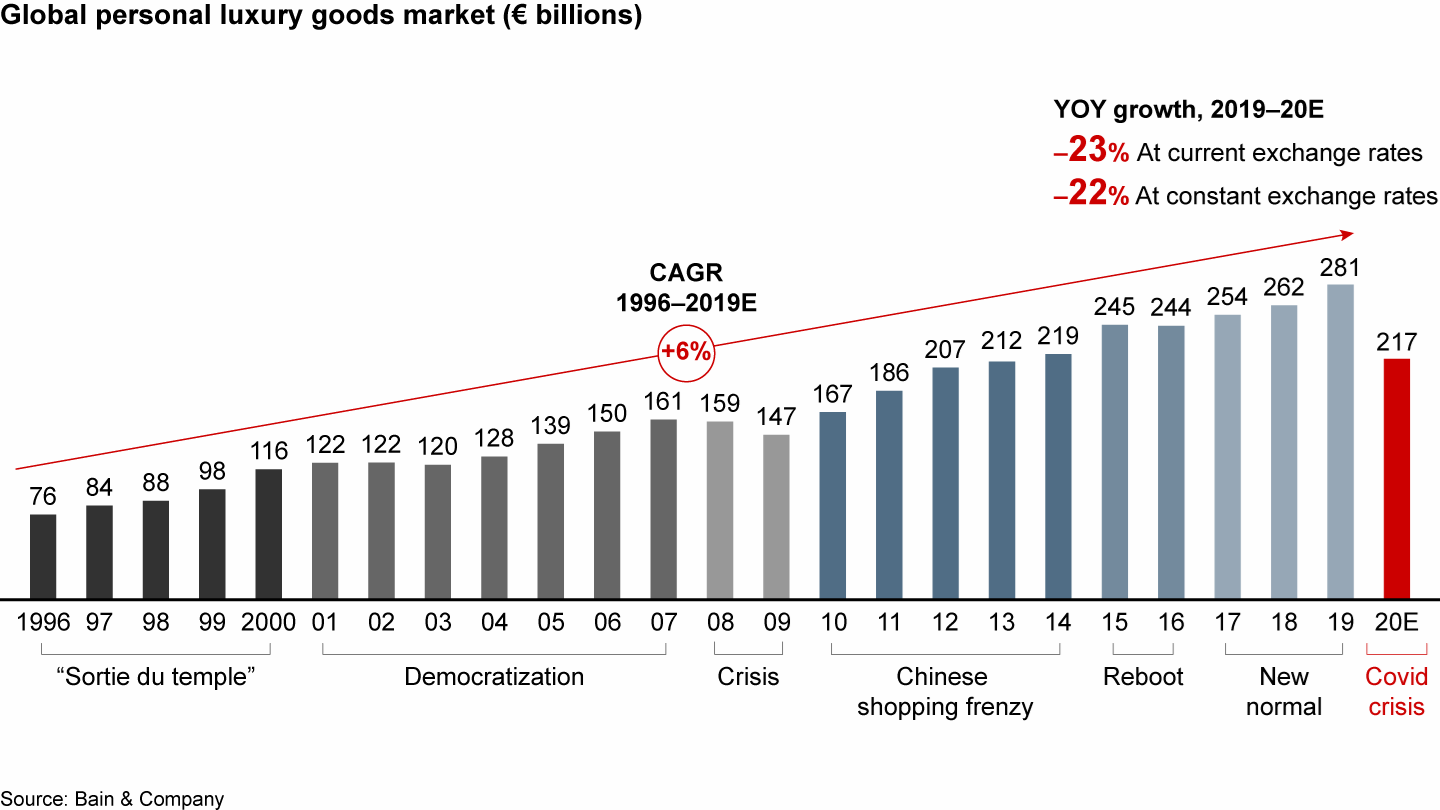
Q2 2020 was the worst quarter ever for personal luxury goods. There are signs of recovery in Q3, but uncertainty is the keyword for the holiday season



2. Regional highlights
- In 2020, the global ranking of luxury sales by region changed quite dramatically. Until 2019, Europe and the Americas were the biggest regions for luxury sales, but in 2020 Asia became the top region for luxury sales.
- This is largely driven by the performance of Mainland China, which has been the only region globally to end the year on a positive note, growing by 45% at current exchange rates to reach €44 billion. Local consumption rebounded quickly and accelerated week after week, roaring ahead across all channels, categories, generations and price points. Travel retail in Mainland China experienced a boom this year, particularly in Hainan. However, total purchases made by Chinese customers experienced a 30%–35% decline, due to Chinese customers not traveling: Purchases made abroad (historically up to two-thirds of total purchases by Chinese customers) thus declined by 70%.
- Japan shrank by 24% at current exchange rates to €18 billion. Japanese customers refrained from spending during the crisis, but favored timeless brands viewed as long-term investments.
- The rest of Asia struggled, contracting by 35% at current exchange rates to reach €27 billion. Hong Kong and Macau were among the worst performers globally. South Korean consumers showed strong appetite for luxury consumption, yet the duty-free market slumped. In Southeast Asia, a small and developing local customer base was not able to offset the collapse in tourism.
- Europe has borne the brunt of a collapse in global tourism. Demand fell by 36% at current exchange rates to €57 billion. In the second quarter, it was the worst-performing region globally, due to lack of tourism, lockdown measures, store network closures and low consumer confidence. However, local consumption showed resilience: Purchases by European customers decreased only by 10%–15%. Local consumption moved to wealthy areas and showed the biggest shift to the online channel globally. Among European countries, Russia experienced the best performance.
- The Americas experienced less impact: The market fell by 27% at current exchange rates to €62 billion. In the US, local consumption showed the same resilience as in Europe (–10% to –15%). Despite lockdowns and political uncertainty, there were positive signs of a restart in Q3 due to the stimulus package. Department stores seem to have reached a point of no return and face an uncertain future. The map of luxury consumption seems to be redrawn to move away from city centers. In South America, Brazil performed better than the regional average.
- Overall, the rest of the world contracted by 21% at current exchange rates to €9 billion. The impact in the Middle East was mitigated by shorter lockdowns and repatriation of spending previously made abroad, though with different nuances among countries within the region (the United Arab Emirates was most impacted). In Australia, the halt in tourism amplified a slowdown from the wildfires.
- Regional shifts mark an acceleration of a rebalancing of where luxury purchases take place, as tourists shift to buy in their home markets. The share of purchases made locally reached 80%–85% this year, and we expect it to represent between 65% and 70% as domestic purchases regain relevance, especially in China and the broader Asian region.
Asia became the top region for luxury sales by value

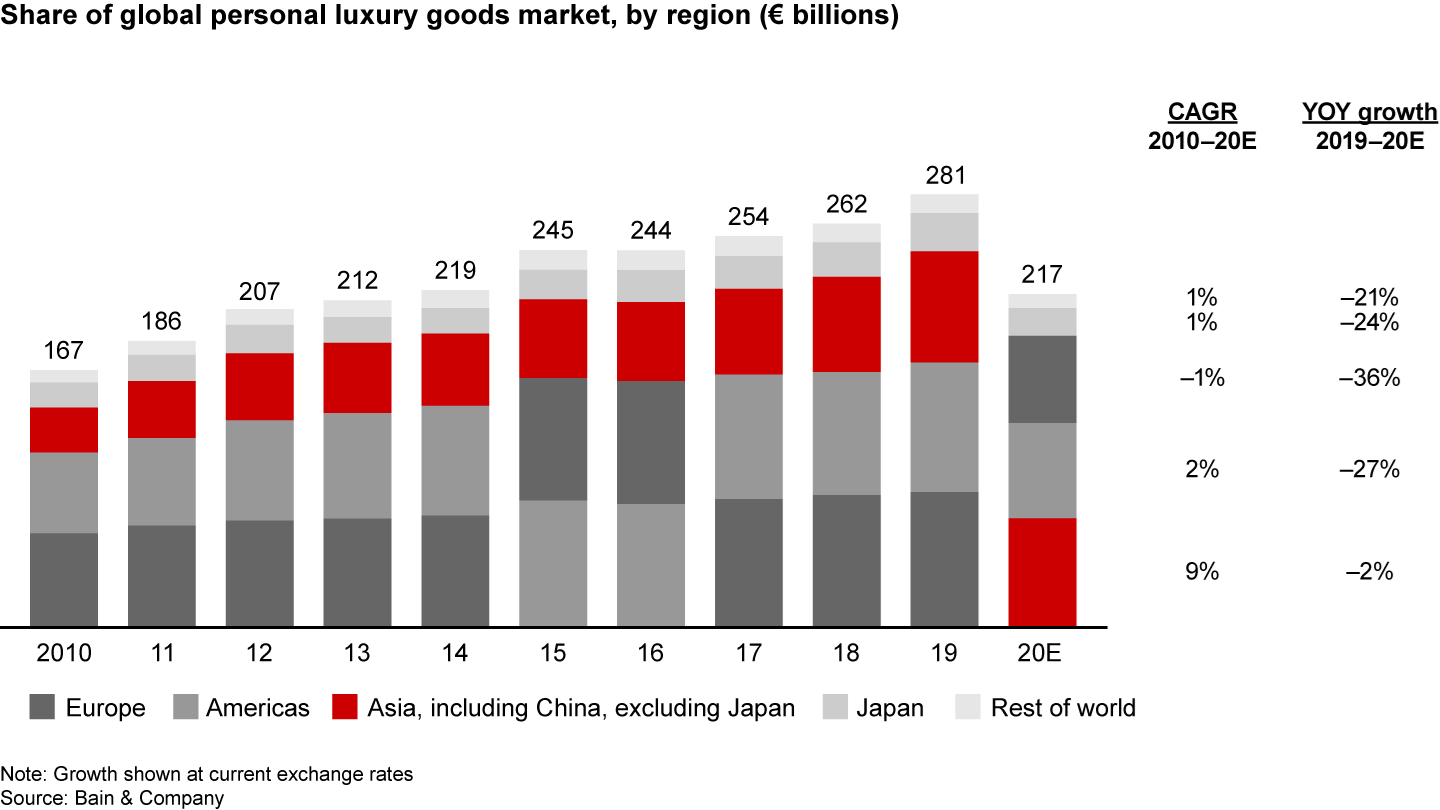
China was the best performing country but had the most affected customers (not traveling); Europe was the most affected region but had the best performing customers (locally)


The global luxury market, historically tourism dependent, confirmed its more local nature in 2020 and should continue doing so in the coming years



3. Distribution trends
- Wholesale remained the largest channel for luxury goods, accounting for 54% of all sales. Yet the retail channel resisted better, growing its share to 46% (up from 40%).
- The distribution landscape underwent a significant transformation in 2020. Three channels were particularly affected: travel retail (due to the freeze in world travel), department stores and specialty stores. Monobrand stores and outlets also suffered due to closures, but were able to maintain their share.
- Online was the fastest-growing channel, increasing by 50% and nearly doubling its share to reach 23% of luxury sales globally (up from 12% in 2019). Online sales made up €49 billion in 2020, up from €33 billion in 2019. Globally, the online channel influenced 85% of luxury transactions (compared with 75% in 2019), and 40% to 50% of purchases were digitally enabled (compared with 20% to 25% in 2019).
- Online’s dramatic increase comes at the expense of brick-and-mortar stores. Bain expects no growth in the number of stores operated directly by brands in 2020 and a possible decline in store footprints in 2021. Brands will need to adjust their footprints to the new map of luxury buying, evolve the store role and its ergonomics, and maximize the customer experience.
- The wave of transformation should not leave wholesale distribution untouched: Perimeter contraction, polarized performance and entry of new players will lead luxury brands to increase their control on the channel.
Wholesale remained the dominant channel for luxury goods, but owned retail resisted better

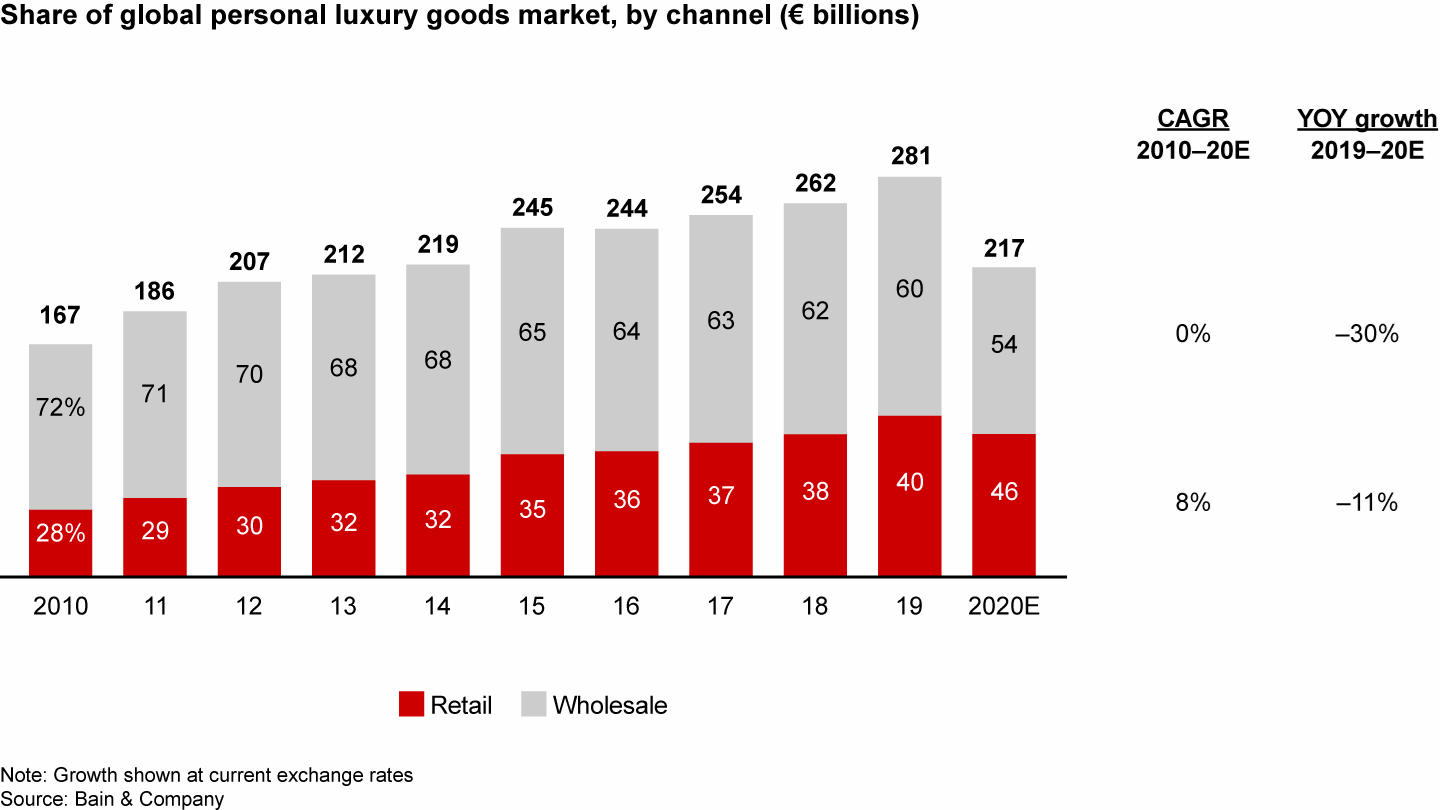
All brick-and-mortar channels were dramatically hit in 2020, leading to a distribution ecosystem transformation


Online luxury doubled its share of the global market in 2020, a skyrocketing performance worth five years of growth



4. Individual category performance
- Accessories remained the largest personal luxury goods category and decelerated less than the average. This category represented 36% of the total personal luxury goods market in 2020.
- Beauty, leather goods and apparel continued to make up the bulk of global luxury purchases, amounting to €48 billion, €47 billion and €45 billion, respectively.
- Beauty purchases declined at 20% compared with 2019. The category was strongly affected by the shutdown of specialized stores and travel retail. The online channel and the APAC region acted as the category’s only “lungs.” Cosmetics (particularly skin care) performed better than fragrances.
- Leather goods decreased by 18%. Entry items (supported by e-commerce) and iconic products (supported by high-spending consumers in Asia) resisted better than the average.
- Apparel and watches both declined by 30%. In apparel, lockdown policies negatively impacted demand for formal wear, and in contrast, drove strong demand for streetwear and athleisure. Apparel players faced increasing competition from social media savvy, direct-to-consumer brands. Menswear and womenswear declined at the same pace, albeit with different patterns by region. For watches, global purchases amounted to €27 billion. The poor performance of the category was mitigated by the resilience of the online channel, the China market and the most iconic brands and models.
- Shoes and jewelry were the product categories that decelerated the least. Shoe purchases fell by only 12% to €19 billion, cushioned by demand in casual models (including sports and functional models, such as sneakers), while demand for formal and classic models contracted. Jewelry saw sustained demand in Asia and benefited from online sales. That category remains polarized with high jewelry and iconic entry-priced items leading the recovery.
- Across product categories, entry-price items gained in relevance, reaching more than 50% of volumes sold in 2020. In the quest for pricing relevance, the rules of the game are rapidly changing accessible luxury as we knew it, due to increasing competition from new, insurgent brands with relevant purpose and innovative business models.
Despite a strong deceleration, accessories remained the largest personal luxury goods category

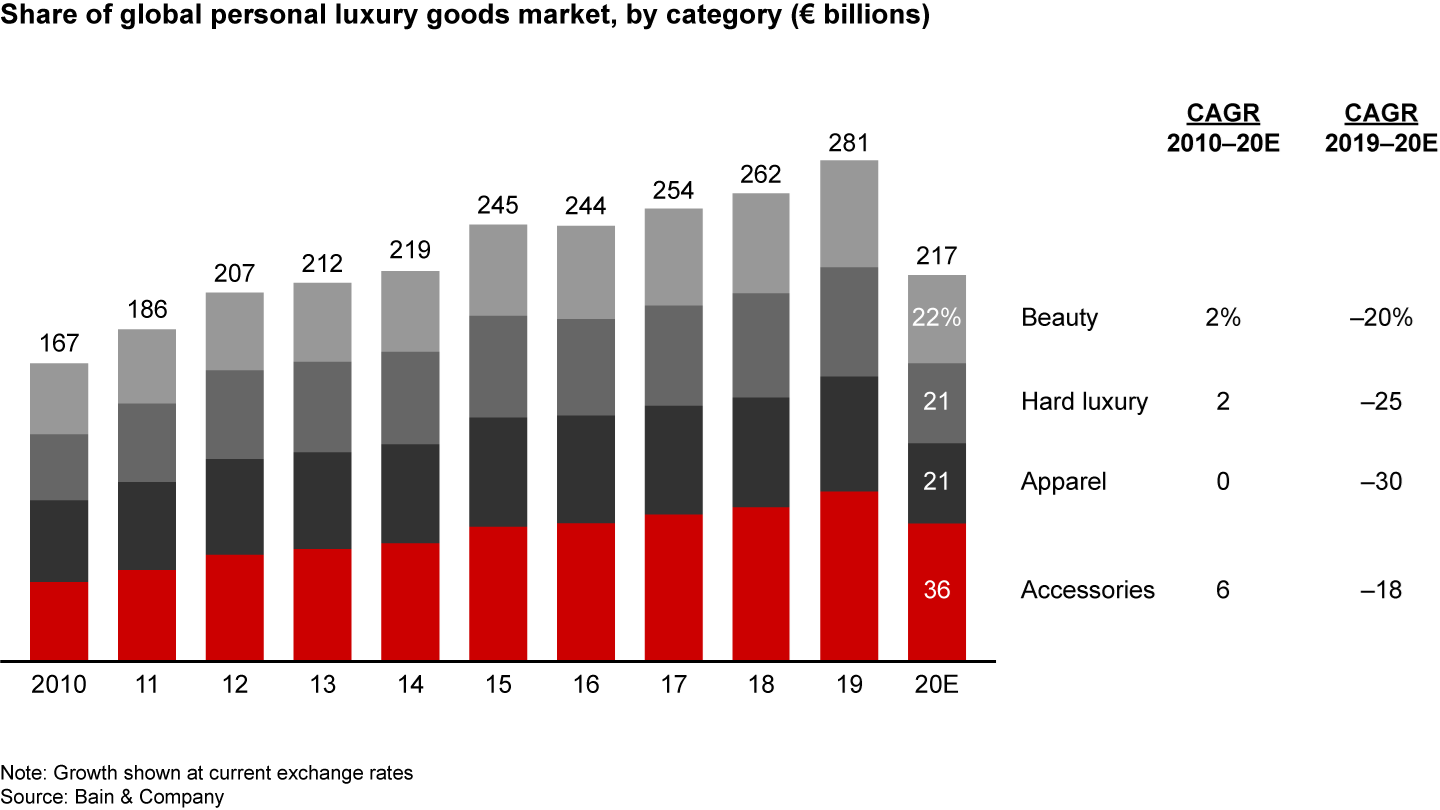
Shoes and jewelry were the product categories that decelerated the least, followed by leather goods and beauty

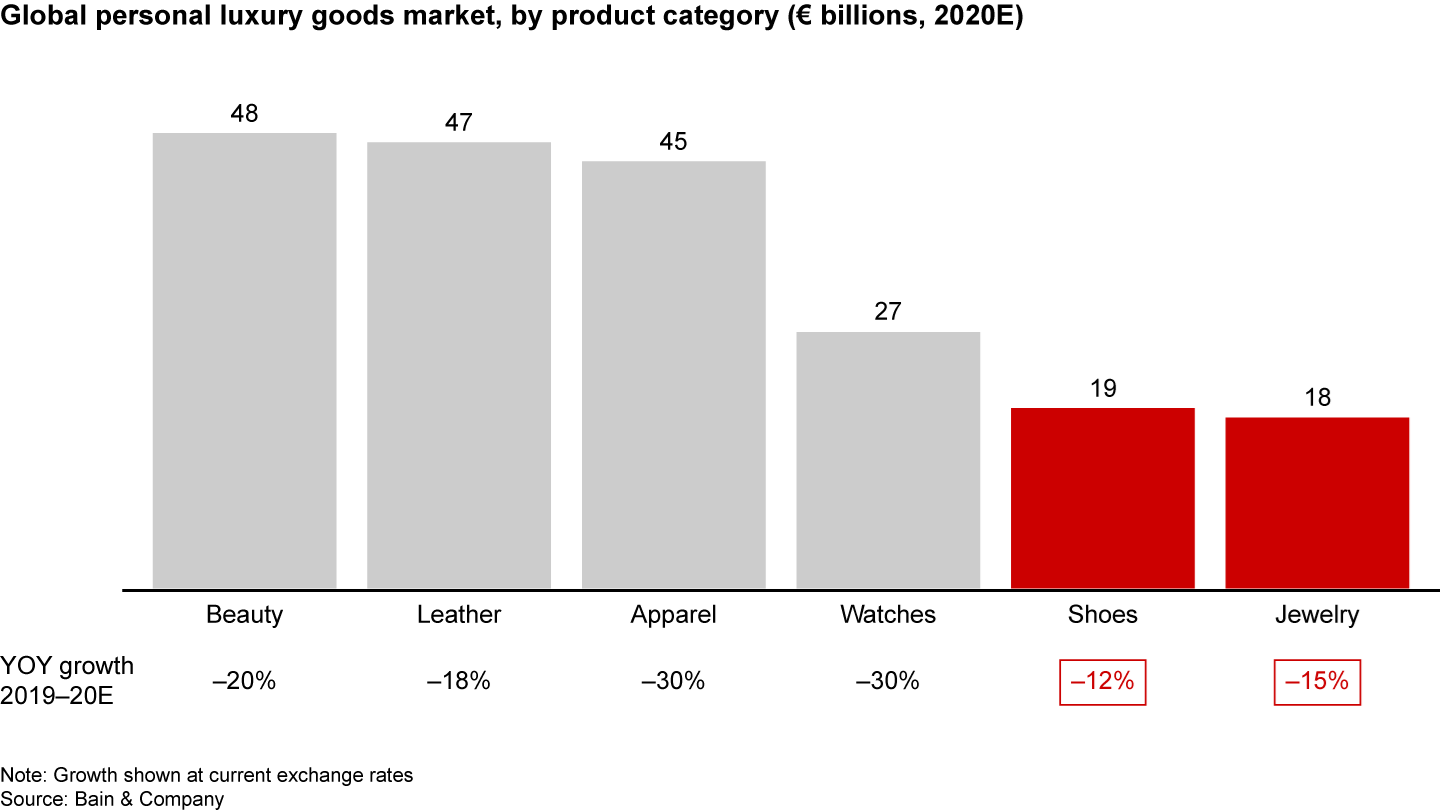

5. Outlook for the future
- It has been a year of profound change in the way global luxury consumers live and shop and in what they value. Scenarios for 2021 are varied, and Bain forecasts growth that ranges from +10%/12% to +17%/19%, depending on macroeconomic conditions, the evolution of Covid-19 and the speed of return to travel globally, as well as the resilience and confidence of local customers.
- The decline in revenue in 2020 should take a disproportionate toll on profitability—we expect operating profit to decline by 60% in 2020 compared with 2019 (i.e., from an average of 21% margin to 12% margin). According to our analysis, in 2021 the market is expected to recover 50% of the profit loss of 2020—but still remain below 2019 levels. This is due to requirements to continue spending, and sometimes even accelerate investment, on most cost items (marketing, online channels, store costs) despite the drop in sales.
- We expect the recovery to gather pace over the next three years, with the personal luxury goods market returning to 2019 levels by the end of 2022 or early 2023. Over the longer run, the market for personal luxury goods should flourish again, growing at an anticipated 10% per annum between 2020 and 2025.
- In the years ahead, we anticipate four growth engines to profoundly reshape the luxury market by 2025:
- Chinese consumers will become a dominating nationality for luxury, growing to represent over 45% of global purchases.
- Mainland China is on a path to become the biggest luxury market.
- Online is set to become the leading channel for luxury purchases.
- Younger generations (Generations Y and Z) will be the biggest buyers of luxury, representing over two-thirds of global purchases.
- The industry should come out of the crisis with more purpose and dynamism than before. By 2030, the industry should be drastically transformed. We will not talk of the luxury industry anymore, but of the market for “insurgent cultural and creative excellence.” In this new, enlarged space, winning brands will be those that build on their existing excellence while reimagining the future with an insurgent mindset. Luxury players will need to think boldly to rewrite the rules of the game, transforming their operations and redefining their purpose to meet new customer demands and retain their relevance, especially for younger generations, who are set to drive 180% of the growth in the market from 2019 to 2025. These generations place unprecedented emphasis on diversity and inclusion, in addition to sustainability and environmental issues. These “activist” consumers seek brands that align with their vision and desire for purpose.
Revenue decline disproportionally impacts profitability: 2020 should see a profit reduction of nearly 60%, of which perhaps only half could be recovered in 2021

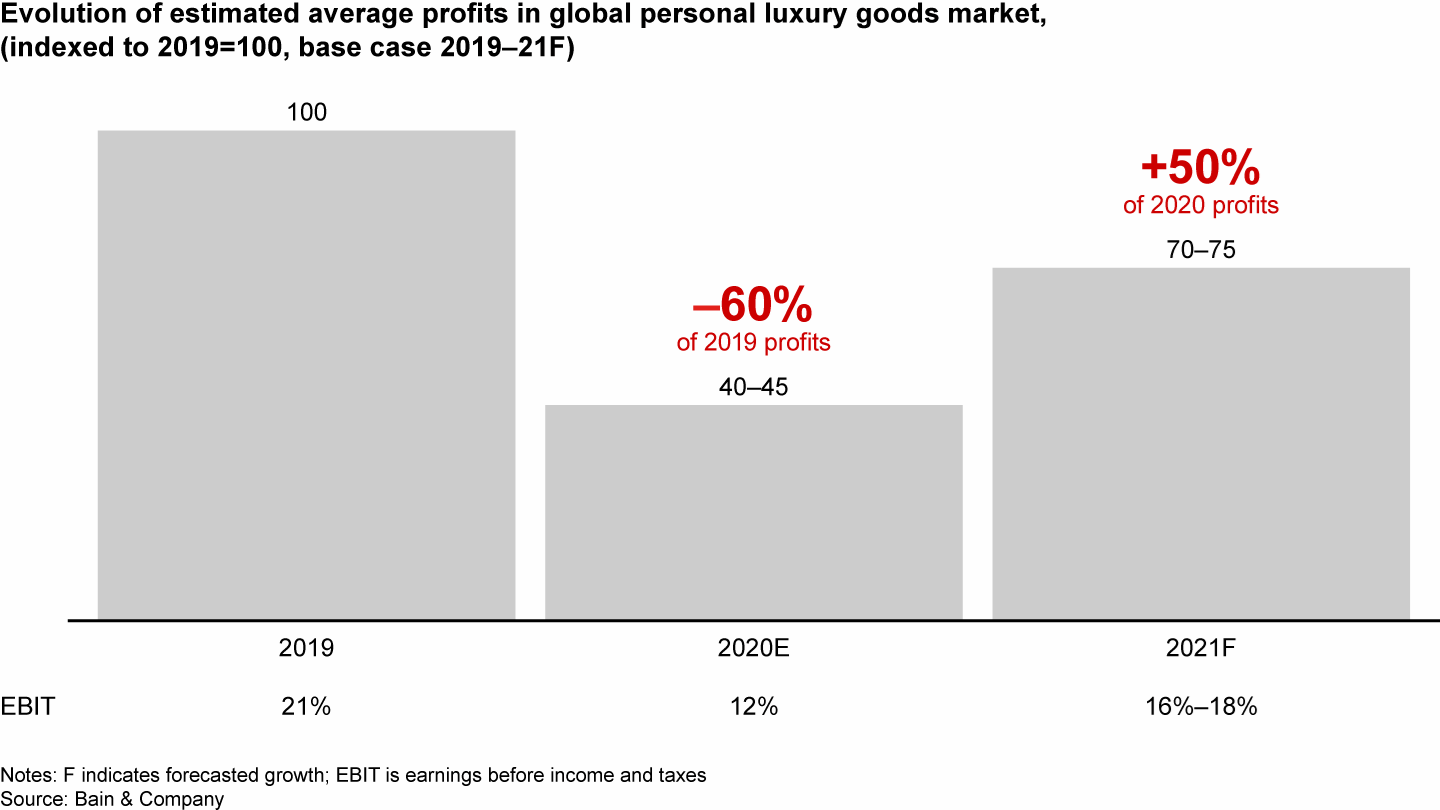
Generational shifts accelerated in 2020, and by 2025 Gen Z and Gen Y should contribute 180% of market growth, representing two-thirds of the total market

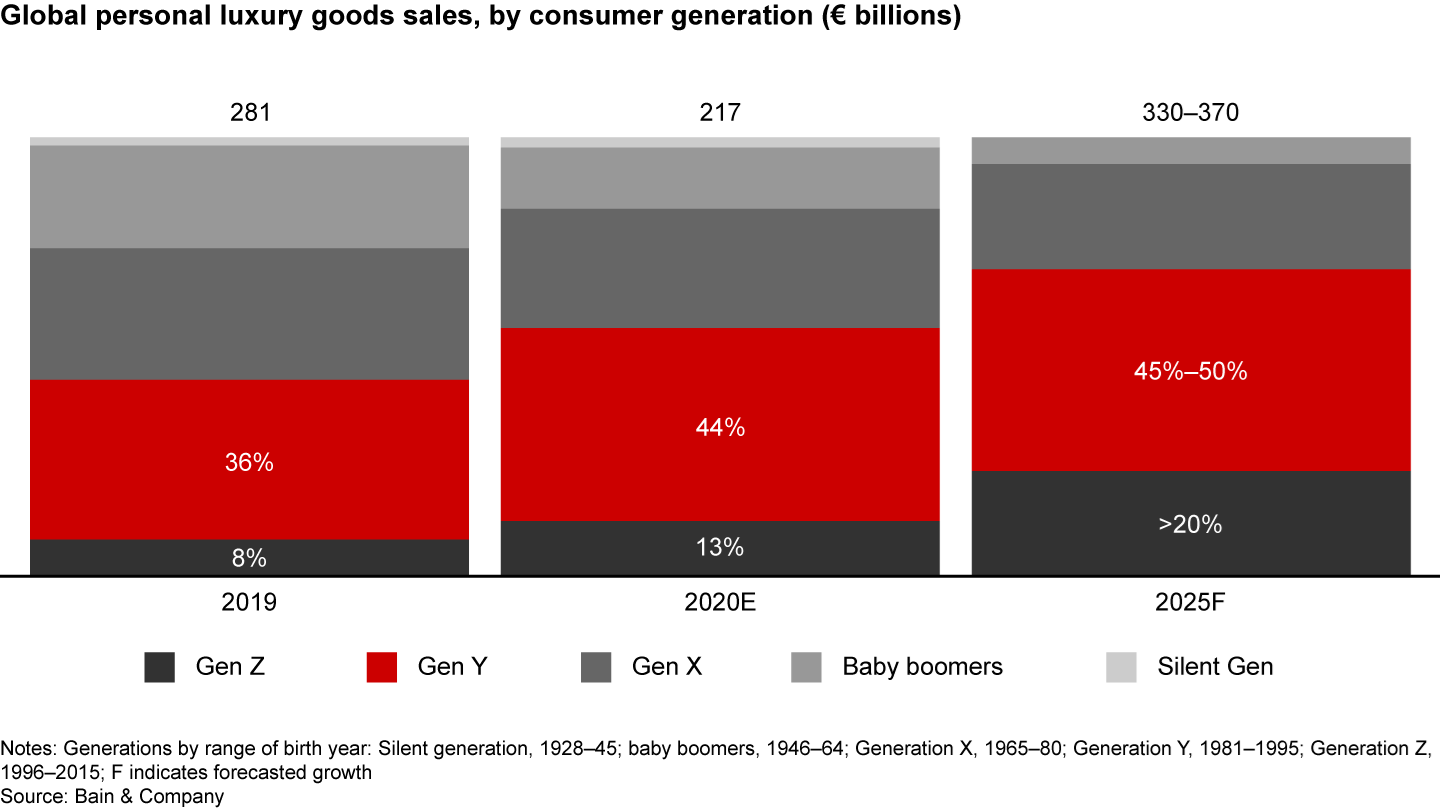
A potential return to 2019 demand levels depends on numerous market factors and is likely to occur only between the end of 2022 and 1H 2023


Beyond 2023, the luxury market should flourish again as companies take the front seat in transforming the industry on behalf of customers


To reach €330 billion–€370 billion by 2025, the market will rely on various growth drivers: Chinese consumers in China, younger generations and online


From “luxury” to “insurgent cultural and creative excellence”—the new CEO agenda

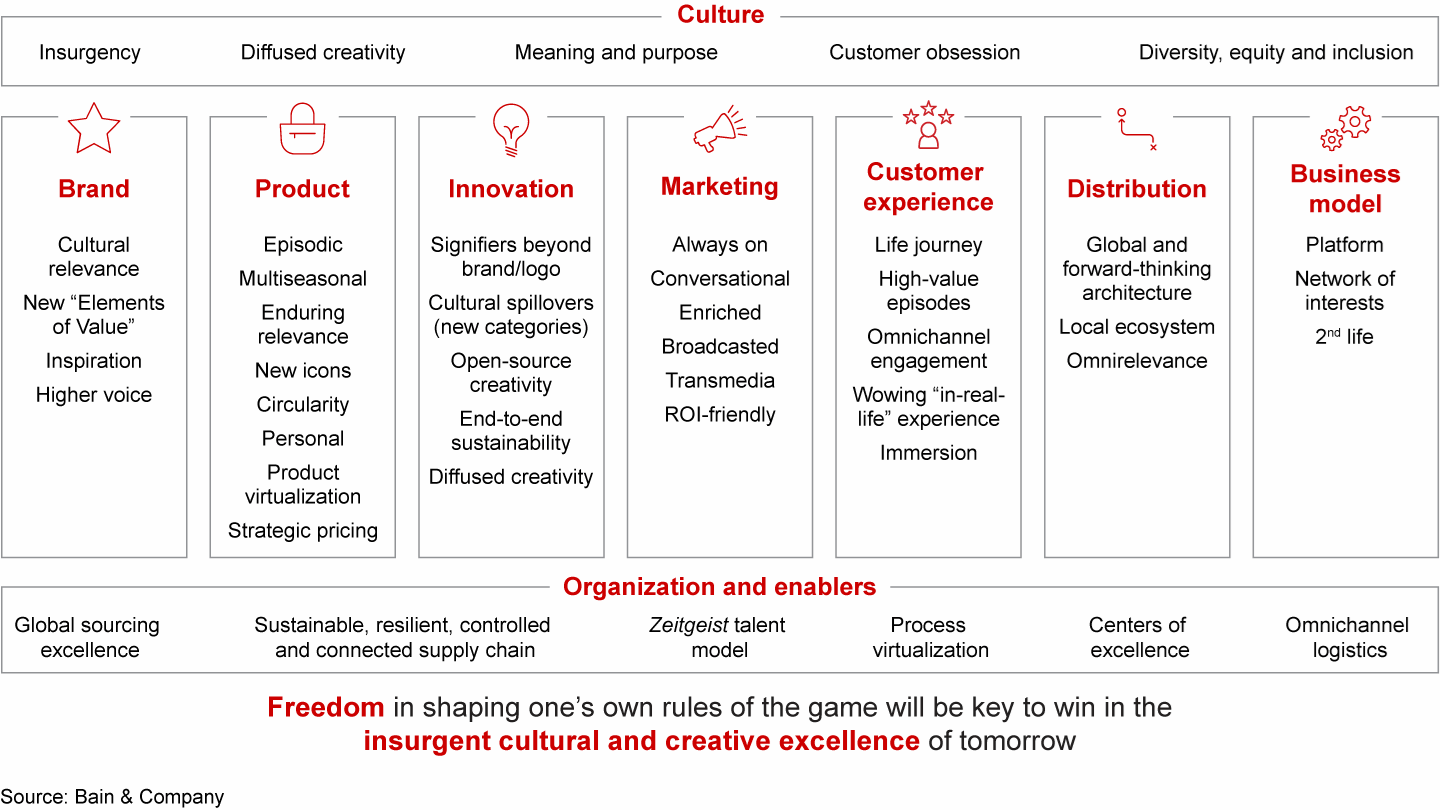
About the Bain Luxury Goods Worldwide Market Study
Bain & Company analyzes for Fondazione Altagamma the market and financial performance of more than 285 leading luxury goods companies and brands. This database, known as the Luxury Goods Worldwide Market Observatory, has become a leading and much-studied source in the international luxury goods industry. Bain has published its annual findings in the Luxury Goods Worldwide Market Study since 2000. The study’s lead author is Claudia D’Arpizio, a Bain partner in Milan. Fondazione Altagamma is led by Matteo Lunelli, who was named chairman in 2020.
Methodology of the study

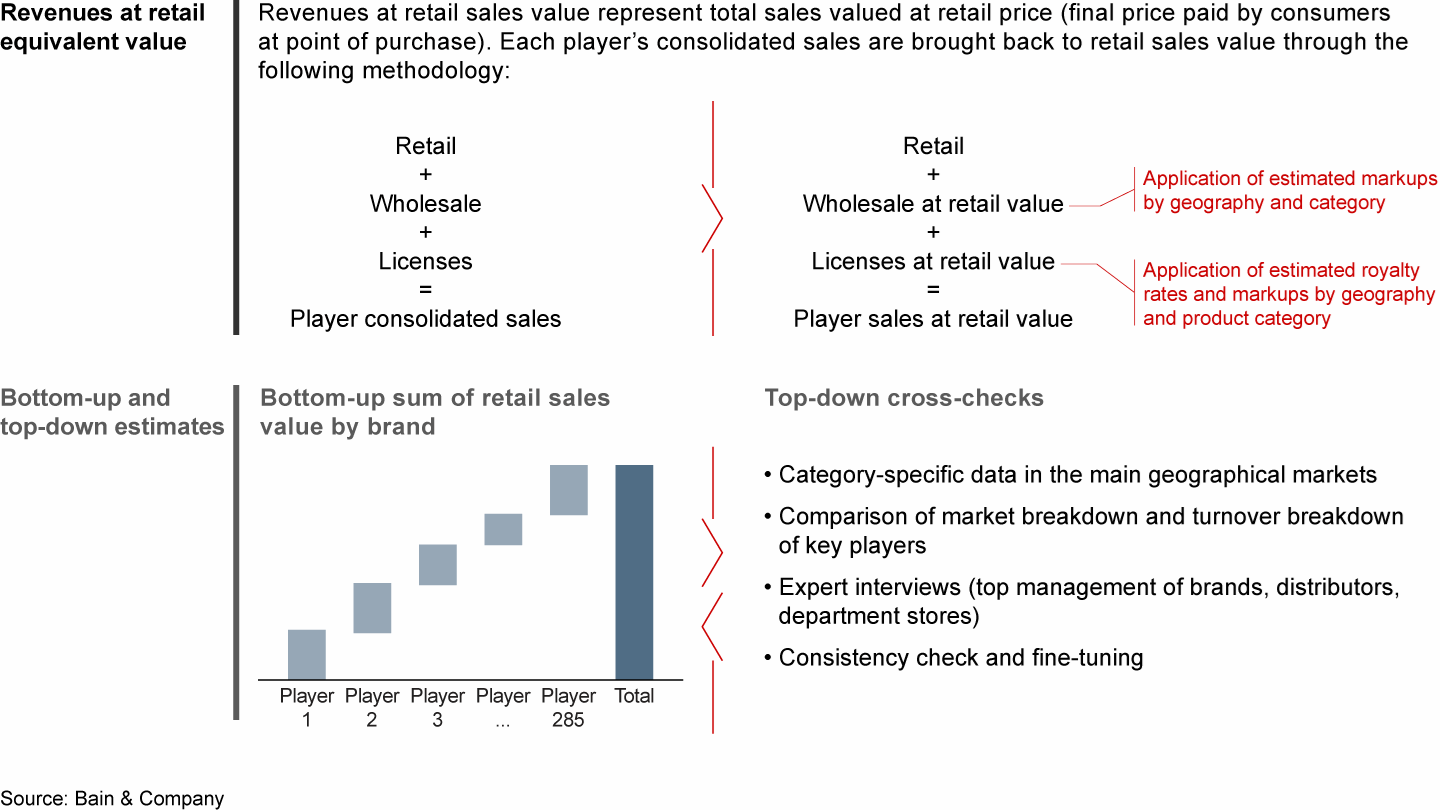
Bain’s post–Covid-19 scenarios and forecasts are based on a triangulation of information and sources, available as of November 12, 2020, including:
- Data regarding the outbreak of Covid-19 and consequential lockdown actions across countries
- Macroeconomic data (e.g., GDP, consumer confidence index, airflow traffic) and their latest forecasts
- Current trading performance from relevant luxury industry players
- Annual reports, quarterly results and analyst reports
- Consensus across hundreds of expert interviews
Our forecasts and scenarios do not take into account some possible disruptive changes to the Covid-19 situation beyond 2020 (e.g., other global waves of Covid-19, or the introduction of a vaccine).

Coronavirus
The global Covid-19 pandemic has extracted a terrible human toll and spurred sweeping changes in the world economy. Across industries, executives have begun reassessing their strategies and repositioning their companies to thrive now and in the world beyond coronavirus.